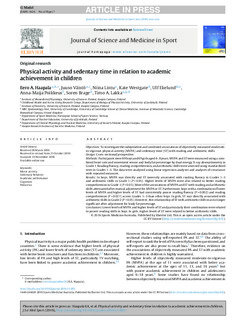Physical activity and sedentary time in relation to academic achievement in children
Haapala, Eero A.; Väistö, Juuso; Lintu, Niina; Westgate, Kate; Ekelund, Ulf; Poikkeus, Anna-Maija; Brage, Søren; Lakka, Timo A.
Journal article, Peer reviewed
Permanent lenke
http://hdl.handle.net/11250/2433067Utgivelsesdato
2016-11Metadata
Vis full innførselSamlinger
- Artikler / Articles [2096]
Originalversjon
Journal of Science and Medicine in Sport. 2016, under utgivelse. doi: http://dx.doi.org/10.1016/j.jsams.2016.11.003 http://dx.doi.org/10.1016/j.jsams.2016.11.003Sammendrag
tObjectives: To investigate the independent and combined associations of objectively measured moderate-to-vigorous physical activity (MVPA) and sedentary time (ST) with reading and arithmetic skills.Design: Cross-sectional/prospective.Methods: Participants were 89 boys and 69 girls aged 6–8 years. MVPA and ST were measured using a com-bined heart rate and movement sensor and body fat percentage by dual-energy X-ray absorptiometry inGrade 1. Reading fluency, reading comprehension, and arithmetic skills were assessed using standardizedtests in Grades 1–3. The data were analyzed using linear regression analyses and analyses of covariancewith repeated measures.Results: In boys, MVPA was directly and ST inversely associated with reading fluency in Grades 1–3and arithmetic skills in Grade 1 (P < 0.05). Higher levels of MVPA were also related to better readingcomprehension in Grade 1 (P < 0.05). Most of the associations of MVPA and ST with reading and arithmeticskills attenuated after mutual adjustment for MVPA or ST. Furthermore, boys with a combination of lowerlevels of MVPA and higher levels of ST had consistently poorer reading fluency (P = 0.002) and readingcomprehension (P = 0.027) across Grades 1–3 than other boys. In girls, ST was directly associated witharithmetic skills in Grade 2 (P < 0.05). However, this relationship of ST with arithmetic skills was no longersignificant after adjustment for body fat percentage.Conclusions: Lower levels of MVPA and higher levels of ST and particularly their combination were relatedto poorer reading skills in boys. In girls, higher levels of ST were related to better arithmetic skills.
